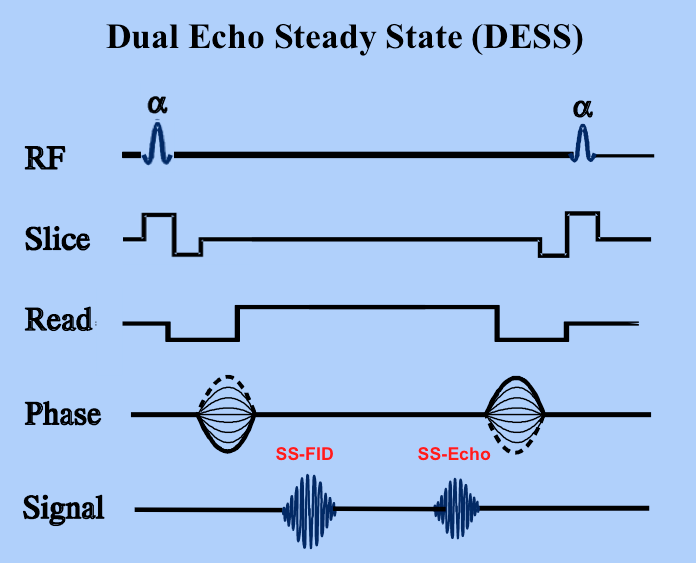|
DESS stands for “Double Echo Steady State” and is a trademarked product by Siemens. In earlier literature, this sequence was known by the acronym “FADE (FAst Double Echo”). GE's version is called MENSA (Multi-Echo iN Steady-state Acquisition).
By means of a prolonged and unbalanced readout gradient, DESS generates the FID-like and Echo-like signals from the steady-state free precession individually. It then combines the signals on a pixel-by-pixel basis, thereby increasing signal-to-noise. Phase-encoding and slice-select gradients are balanced to maintain the transverse steady state.
|
 DESS knee image
DESS knee imageTR/TE/α = 18/3/25°
The contrast of DESS is unique as it combines features from both the FID-signal of FISP with the Echo-signal of PSIF. Fluid is extremely bright (reflecting T2/T1 weighting from the PSIF echo signal). Bone is relatively dark due to T2* dephasing from trabeculae (reflecting susceptibility sensitivity of the FISP/FID component). The PSIF/echo contribution makes DESS very sensitive to motion, so its use has been primarily limited to orthopedic applications, such as 3D knee imaging.
Advanced Discussion (show/hide)»
No supplementary material yet. Check back soon!
References
Bruder H, Fischer H, Graumann R, Deimling M. A new steady-state imaging sequence for simultaneous acquisition of two MR images with clearly different contrasts. Magn Res Med 1988;7:35-42.
Thakkar RS, Fammang AJ, Chhabra A et al. 3T MR imaging of cartilage using 3D dual echo steady state (DESS). MAGNETOM Flash (3/2011), pp 33-6.
Bruder H, Fischer H, Graumann R, Deimling M. A new steady-state imaging sequence for simultaneous acquisition of two MR images with clearly different contrasts. Magn Res Med 1988;7:35-42.
Thakkar RS, Fammang AJ, Chhabra A et al. 3T MR imaging of cartilage using 3D dual echo steady state (DESS). MAGNETOM Flash (3/2011), pp 33-6.
Related Questions
There are so many different GRE sequences. Can you make sense of these?
There are so many different GRE sequences. Can you make sense of these?

